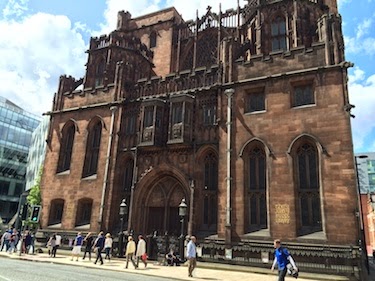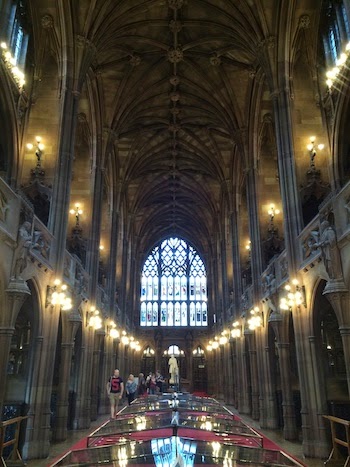 |
| The John Rylands Library |
With it’s gothic design, leaded glass windows, and long main reading room with looming arches, one might assume the building that houses the John Rylands Library was once a cathedral. Its original intention, however, was the same as it is today.
The John Rylands Library, the home of the University of Manchester’s “special collections”, is one of Manchester’s main attractions. It didn’t take much convincing for us to put it high on our list. We love libraries. Among our fondest memories is the Harrison County Library in downtown Gulfport, Mississippi where we grew up, with it’s 60’s modern architecture, terrazzo tile, expanses of glass looking toward the gulf, and that smell. Hurricane Katrina may have destroyed that library, but nothing will take away the smell of old books that is imprinted in the memory of so many of us from the Gulf Coast thanks to that library.
It was that smell that I sought at the Rylands Library in Manchester, England as much as anything, and the flood of memories that smells can bring back.
The exhibits on the lower level are thoughtfully arranged and discuss historical aspects of Europe, emphasizing how books and the printed word affected–and reflect today–the people who used them. For example, one of the displays discusses how the mingling of Dutch and French in what is southern Netherlands today indicates the communities in centuries past borrowed words, phrases, and practices from one another, indicating they were not nearly as segregated as some have believed.
Throughout the library there are, of course early and old books, some dating to just after the invention of the printing press, many of them looking as though they had just been bound yesterday. The creation of a book was an art form, with the kind of meticulous love, care, and craftsmanship you’d expect a monk to put into the Holy Bible, so it’s no surprise that well-made books have endured the centuries.
 |
| An Early Printing of Chaucer’s “The Canterbury Tales” |
Much effort, of course, was put into the production of the bible and its translation into the languages of the world. The library proudly displays a piece of the oldest known papyrus codex (book, as opposed to a papyrus scroll) of the new testament: a three square-inch triangle of the Gospel of John. Nearby are early translations of the bible into Hindi and Bengali, the latter actually prepared by William Carey, the namesake of the university where Lori and I both earned our Master’s degrees.
One level up is the main reading room. It is the nave of this cathedral of books, running the length of the building, with towering leaded glass windows on either end, the sides lined with small “chapels” dedicated to study and the assimilation of the knowledge captured in all the books. This being a library, there are thousands and thousands of books and quiet places to study them.
 |
| The Main Reading Room of The John Rylands Library |
And yes, there is that smell. It is subtle and sometimes fleeting. I thought I caught it the moment we stepped into the ultra modern visitor’s entrance, but it wasn’t until we were tucked away in the smaller reading rooms–the chapels–that it was obvious. It was there I remembered that sweeping staircase in the library back home, the little ponds of goldfish just outside the front door, and how the rows and rows of books in the children’s room were set at just a slight angle.
It might not have been built as a cathedral, but like all libraries, it is a cathedral: dedicated to the pursuit and capture of knowledge and truth.
 |
| A 19th Century Printing Press – Made In America |






